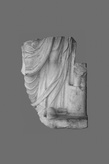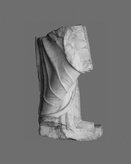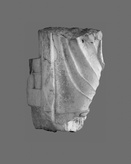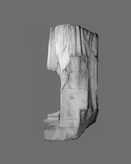- FundeFigs. IV. 56-59
Figs. IV. 56-59
Jerash, Archaeological Museum, without inv.-no.
From Gerasa / Jerash, found in the North Hall of the eastern baths, near the unmolded base no. 11 and the pilaster H, Friedland 2003a, 422 fig. 9.
Coarse-grained, white marble, according to the isotopic analysis probably from Thasos, Cape Vathy (Friedland 2003a, 445).
Broken horizontally through the mid-thighs. Fragments of lest-most scroll and portion of folds on the back attached separately. Missing right ankle and foot, folds on drapery on right side and below right knee, upper portions of right scrolls, right half and back of the plinth. Left side of the scroll case and areas on the back of the piece eroded. Orange-brown incrustations on front, especially on right half of the scroll case, along inner side of right leg, and along drill channels between drapery folds. Light-brown, cement-like incrustations cover right side of the back. Modern tooth-chisel marks cover fold of drapery between legs and area beneath right knee (description by Friedland 2003a, 444).
H 82 cm; W 62 cm; D 37 cm; plinth 33.5 x 28 cm; H of plinth 9–9.5 cm.
The piece preserves the lower third of a draped figure standing upright atop a rectangular plinth. The figure stands with a bent right leg, resting its weight on its left leg and leaning against a support adjacent to its left side. Two-thirds of the left foot emerges from beneath the drapery, standing flat atop the plinth. The foot is shod in a simple, fitted shoe, a calceus equestres, that has a thin sole (0,75 cm thick) and a broad flap folded across its middle (Friedland 2003a, 444).
Much of the figure is sheathed in a toga, whose folds are highly polished and delineated by drill channels. Two gathered folds cut across the figure, creating diagonal axes. One fold wraps around the now missing, right ankle, curves up between the legs, crosses the left leg, then flows up the inner side of the left leg. For the most part, the remainder of the drapery is rendered as relatively flat, so that it clings to the figure’s anatomy to reveal thighs, knees and the right calf. On the left side of the figure and between the legs, the broad folds flow straight downward, ending in a zigzag pattern between the legs. Only two diagonal or arced folds are carved atop the left thigh above the knee. In contrast, the right leg is covered with multiple arc-shaped ridges that cling to the bent leg. The ridges on the right thigh are carved in opposing directions, so that they form interlocking arcs, while those on the calf are concentric. Several smaller folds are carved on the outer side of the leg. A wide, flat fold runs straight down to the left side of the body and ends atop the support, adjacent to the five scrolls.
The support is carved to represent a rounded scroll-case or capsa. Several details of the smoothed case are rendered in low-relief on the front: a border that consists of two narrow bands framing a wider central band (0,4 cm wide) encircles the top of the capsa on the front a latch that crosses the width of this band ends in a square lock with a gamma-shaped key-hole; above the bottom of the case a thin, ornamental elements arch between two knobs; and at the bottom another wide border melds into the plinth. Both borders continue onto the left side of the case, though there they are carved in lower relief. On the left side, a key dangles from a string that is looped around a small knob (string and key: 10,5 cm long). Five scrolls stand upright inside the case. Two are visible from the front, three from the left side, and two from the back. These five scrolls are banded together by a thin fillet (0,1 cm wide), visible on the left side and back of the scrolls.
Around the mid of the 2nd century AD, Antonine.
Bibl.: Friedland 2001, 474–476 no. 5 fig. 15–18; Gadara I, 490 no. C 13 pl. 130A–D; Friedland 2003a, 444–445 no. 5 fig. 5.



